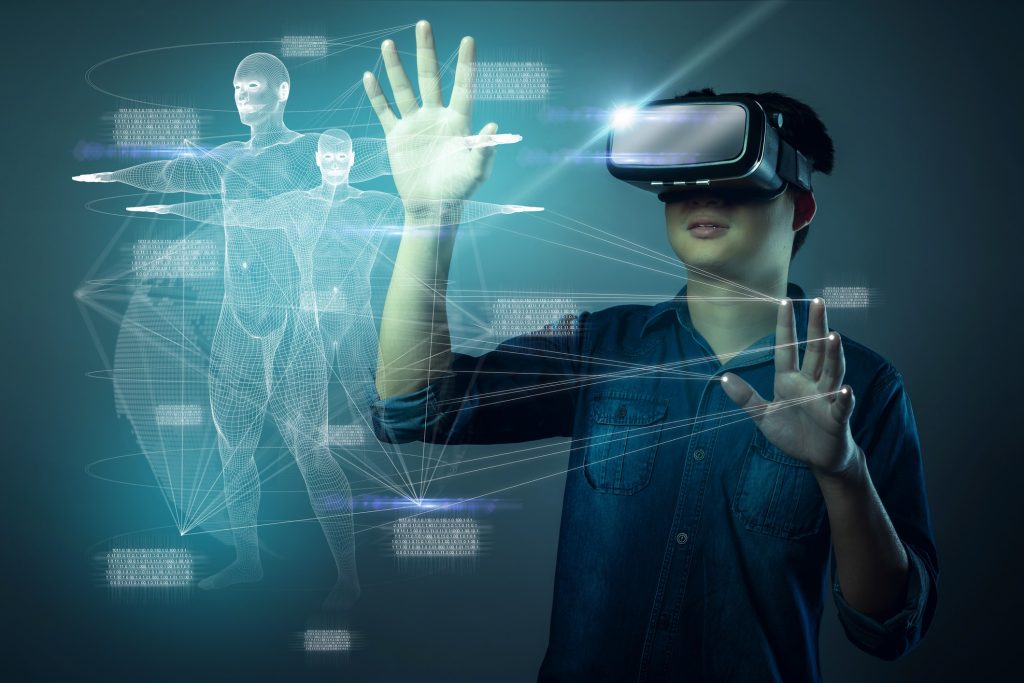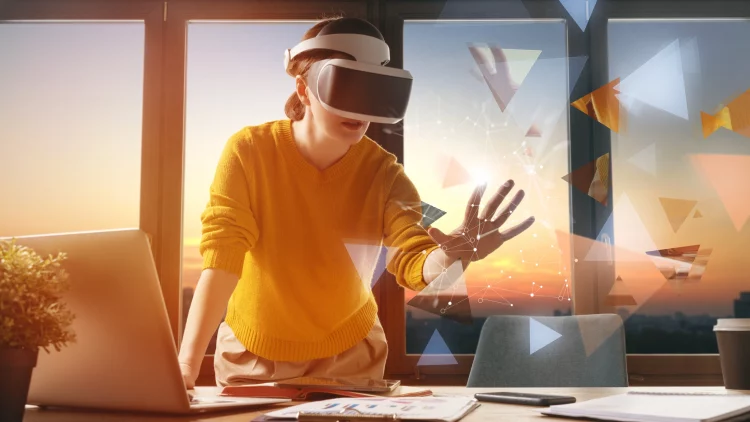Introduction: The Rise of Immersive Technologies in the Digital Age
In recent years, Virtual Reality (VR) and Augmented Reality (AR) have evolved from niche technologies primarily associated with gaming and entertainment into powerful tools with transformative potential for a wide range of industries. These technologies, both part of the broader spectrum of immersive technologies, are reshaping how we interact with digital content, blurring the lines between the physical and digital worlds.
While VR immerses users entirely in a simulated environment, AR enhances the real world by overlaying digital content onto it. Together, they offer exciting possibilities not only for entertainment but also for business applications across sectors such as retail, healthcare, education, real estate, and manufacturing.
This article will explore the evolution of VR and AR, their applications in entertainment, and their growing influence in the business world, focusing on the innovative ways these technologies are being used to enhance customer experiences, improve productivity, and drive new business models.
1. Understanding Virtual Reality (VR) and Augmented Reality (AR)
1.1 What is Virtual Reality (VR)?
Virtual Reality (VR) is an immersive technology that uses computer-generated simulations to create realistic or imaginative environments that users can interact with. VR typically involves the use of headsets and sometimes additional controllers, gloves, or motion tracking systems that allow users to experience a 360-degree environment.
VR works by simulating a three-dimensional space, providing users with visual, auditory, and sometimes haptic (touch-based) sensations that make them feel as though they are physically inside the digital world. Unlike traditional screens, VR offers a fully immersive experience, allowing users to interact with the virtual environment in real-time.
Key components of VR systems include:
- Headsets: Devices like the Oculus Rift, HTC Vive, and PlayStation VR that display the virtual world to the user.
- Controllers: Devices that track the user’s hand movements, enabling interaction with the virtual environment.
- Tracking Systems: Sensors that detect head, hand, and body movements, providing real-time feedback to create an immersive experience.
1.2 What is Augmented Reality (AR)?
Augmented Reality (AR) differs from VR in that it enhances the real world with digital information rather than creating a completely simulated environment. AR overlays virtual elements, such as images, sounds, and text, on top of real-world objects, providing a mixed reality experience.
The most common AR devices include smartphones and AR glasses (such as Microsoft HoloLens and Google Glass). These devices use the camera and sensors to detect the user’s surroundings and then project digital content onto the real world. The digital objects remain anchored in the user’s environment as they move, allowing for interactive experiences that bridge the physical and digital worlds.
Key features of AR include:
- Real-Time Interaction: AR adapts to real-world changes as the user moves, ensuring that the virtual content remains consistent with the environment.
- Location-Based Services: AR often uses location data (GPS) to provide context-aware information, such as directions or local advertisements.
2. Virtual Reality and Augmented Reality in Entertainment
2.1 The Role of VR in Gaming and Entertainment
Virtual reality has made significant strides in the gaming industry, providing a more immersive and interactive experience for players. VR gaming systems, like the Oculus Rift, HTC Vive, and PlayStation VR, have transformed traditional gameplay by placing players in the center of their virtual worlds.
In VR gaming, players can physically interact with the game environment, whether it’s by moving their body to navigate through virtual spaces or by using hand controllers to manipulate objects. This level of immersion is far beyond traditional console or PC gaming, allowing for experiences that feel more realistic and emotionally engaging.
Beyond gaming, VR is also being used for:
- Virtual Concerts: Artists and performers are using VR to create virtual concerts and immersive performances that audiences can experience remotely, enhancing accessibility and engagement.
- Themed Attractions: VR has become a key element in theme park rides, offering immersive experiences that combine virtual environments with physical movements to create thrilling and interactive attractions.
2.2 The Impact of AR on Entertainment and Media
While VR has revolutionized the way we experience virtual worlds, AR has been more focused on enhancing real-world interactions. In entertainment, AR enables users to interact with their physical environment in new ways. The Pokémon GO game is one of the most famous examples of AR’s success in entertainment, allowing players to catch virtual Pokémon in real-world locations using their smartphone screens.
AR is also making its way into movies, where interactive AR experiences allow audiences to engage with the film’s storyline in a more immersive and participatory way. For instance, AR-enabled movie posters or app integrations allow fans to access behind-the-scenes content, experience storylines in new ways, or interact with characters from the movie in real-time.

3. The Expanding Horizons of VR and AR in Business
3.1 The Use of VR in Business Applications
Although VR was initially popularized in entertainment, its applications in business are growing rapidly, particularly in the areas of training, product design, and customer engagement.
- Employee Training: VR has proven to be an effective tool for training simulations across various industries. For example, medical students use VR to practice surgeries, while pilots and military personnel use VR for realistic training in controlled environments. VR training provides a safe and cost-effective way to simulate complex scenarios without the risks associated with real-world training.
- Product Design and Prototyping: Companies in sectors like automotive, aerospace, and consumer electronics use VR to create digital prototypes of new products, allowing designers to visualize and interact with their creations before physical prototypes are built. This helps to save time and resources during the design process.
- Virtual Showrooms and Retail: Retailers are leveraging VR to create virtual showrooms where customers can interact with products from the comfort of their homes. VR allows consumers to experience products in a virtual environment, helping them make purchasing decisions without physically visiting a store.
3.2 AR’s Role in Enhancing Business Operations
Augmented Reality (AR) is increasingly being used to improve business operations across various industries. By overlaying digital content on the physical world, AR can help companies streamline processes, enhance customer service, and improve productivity.
- Retail and E-Commerce: AR is enhancing the shopping experience by allowing customers to try on clothes or visualize furniture in their homes before making a purchase. Companies like IKEA use AR apps to help customers visualize how furniture will look in their living rooms, providing a more interactive shopping experience.
- Healthcare: AR is transforming healthcare by improving patient care and medical training. Surgeons can use AR glasses to overlay critical information, such as patient data and imaging results, during operations, increasing precision and efficiency. Medical students can also use AR to simulate complex surgeries and gain hands-on experience in a risk-free environment.
- Field Service and Maintenance: AR is used in field service and maintenance by providing technicians with real-time information and instructions. For example, using AR glasses, technicians can receive step-by-step visual guides on how to repair machinery or install equipment, improving efficiency and reducing errors.
3.3 The Role of AR and VR in Marketing and Customer Engagement
Both AR and VR are transforming how businesses engage with customers. Interactive experiences created by these technologies help brands build deeper emotional connections with their audiences.
- Virtual Product Demos: Companies can use VR to showcase their products in an immersive environment, allowing potential customers to interact with the product virtually. This is particularly effective in industries like real estate, where VR tours allow buyers to explore properties remotely.
- AR-Enhanced Advertising: AR is being used in advertising to create interactive campaigns that allow consumers to engage with ads in a more dynamic way. For example, print ads with embedded AR codes can trigger 3D models of products or immersive experiences when viewed through a smartphone.
4. Challenges and Future Directions for VR and AR
While VR and AR have made significant advancements, several challenges remain in their widespread adoption, especially in business applications.
- Cost: High-quality VR and AR hardware, such as headsets and AR glasses, remain expensive, limiting access to these technologies for small and medium-sized enterprises.
- Content Development: Creating immersive and engaging VR and AR experiences requires skilled developers and designers, making content creation time-consuming and costly.
- User Experience: For AR and VR to achieve mass adoption, the user experience must improve. VR users often experience motion sickness, and AR devices can be bulky or uncomfortable for long-term wear.
However, as technology continues to advance and costs decrease, we can expect to see more seamless and accessible VR and AR experiences. The future of immersive technologies lies in creating solutions that are not only effective but also user-friendly, leading to greater adoption across industries.
Conclusion: The Expanding Role of VR and AR
From entertainment to business, VR and AR are opening new doors for innovation, transforming how we interact with the world and each other. These immersive technologies are already having a significant impact, enhancing customer engagement, improving training, and streamlining business operations.
While challenges remain, the potential for VR and AR to reshape industries is undeniable. As the technology matures and becomes more accessible, we are likely to see even more creative and transformative applications across sectors. With continued development, both Virtual Reality and Augmented Reality will become essential tools for businesses looking to stay ahead in an increasingly digital world.











































